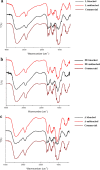Antimicrobial properties of chitosan from different developmental stages of the bioconverter insect Hermetia illucens
- PMID: 35577828
- PMCID: PMC9110362
- DOI: 10.1038/s41598-022-12150-3
Antimicrobial properties of chitosan from different developmental stages of the bioconverter insect Hermetia illucens
Abstract
Growing antimicrobial resistance has prompted researchers to identify new natural molecules with antimicrobial potential. In this perspective, attention has been focused on biopolymers that could also be functional in the medical field. Chitin is the second most abundant biopolymer on Earth and with its deacetylated derivative, chitosan, has several applications in biomedical and pharmaceutical fields. Currently, the main source of chitin is the crustacean exoskeleton, but the growing demand for these polymers on the market has led to search for alternative sources. Among these, insects, and in particular the bioconverter Hermetia illucens, is one of the most bred. Chitin can be extracted from larvae, pupal exuviae and dead adults of H. illucens, by applying chemical methods, and converted into chitosan. Fourier-transformed infrared spectroscopy confirmed the identity of the chitosan produced from H. illucens and its structural similarity to commercial polymer. Recently, studies showed that chitosan has intrinsic antimicrobial activity. This is the first research that investigated the antibacterial activity of chitosan produced from the three developmental stages of H. illucens through qualitative and quantitative analysis, agar diffusion tests and microdilution assays, respectively. Our results showed the antimicrobial capacity of chitosan of H. illucens, opening new perspectives for its use in the biological area.
© 2022. The Author(s).
Conflict of interest statement
The authors declare no competing interests.
Figures




Similar articles
-
Characterization of chitin and chitosan derived from Hermetia illucens, a further step in a circular economy process.Sci Rep. 2022 Apr 22;12(1):6613. doi: 10.1038/s41598-022-10423-5. Sci Rep. 2022. PMID: 35459772 Free PMC article.
-
A comprehensive characterization of Hermetia illucens derived chitosan produced through homogeneous deacetylation.Int J Biol Macromol. 2024 Jun;271(Pt 2):132669. doi: 10.1016/j.ijbiomac.2024.132669. Epub 2024 May 25. Int J Biol Macromol. 2024. PMID: 38801847
-
Hermetia illucens-Derived Chitosan: A Promising Immunomodulatory Agent for Applications in Biomedical Fields.Biomacromolecules. 2025 May 12;26(5):3224-3233. doi: 10.1021/acs.biomac.5c00362. Epub 2025 Apr 29. Biomacromolecules. 2025. PMID: 40300853 Free PMC article.
-
Current Status and New Perspectives on Chitin and Chitosan as Functional Biopolymers.Appl Biochem Biotechnol. 2017 Apr;181(4):1314-1337. doi: 10.1007/s12010-016-2286-2. Epub 2016 Oct 27. Appl Biochem Biotechnol. 2017. PMID: 27787767 Review.
-
Obtaining chitin, chitosan and their melanin complexes from insects.Int J Biol Macromol. 2021 Jan 15;167:1319-1328. doi: 10.1016/j.ijbiomac.2020.11.086. Epub 2020 Nov 14. Int J Biol Macromol. 2021. PMID: 33202268 Review.
Cited by
-
Insulin-Loaded Chitosan-Cellulose-Derivative Hydrogels: In Vitro Permeation of Hormone through Strat-M® Membrane and Rheological and Textural Analysis.Polymers (Basel). 2024 Sep 16;16(18):2619. doi: 10.3390/polym16182619. Polymers (Basel). 2024. PMID: 39339083 Free PMC article.
-
Locust protein hydrolysates have the potential to enhance the storage stability of cheese.Curr Res Food Sci. 2023 Aug 3;7:100561. doi: 10.1016/j.crfs.2023.100561. eCollection 2023. Curr Res Food Sci. 2023. PMID: 37589018 Free PMC article.
-
Metabolic diversity and responses of anteater clostridial isolates to chitin-based substrates.Front Vet Sci. 2025 Feb 19;12:1459378. doi: 10.3389/fvets.2025.1459378. eCollection 2025. Front Vet Sci. 2025. PMID: 40046417 Free PMC article.
-
Next-Generation Wound Healing Materials: Role of Biopolymers and Their Composites.Polymers (Basel). 2025 Aug 19;17(16):2244. doi: 10.3390/polym17162244. Polymers (Basel). 2025. PMID: 40871190 Free PMC article. Review.
-
Chitosan-Integrated Curcumin-Graphene Oxide/Copper Oxide Hybrid Nanocomposites for Antibacterial and Cytotoxicity Applications.Antibiotics (Basel). 2024 Jul 3;13(7):620. doi: 10.3390/antibiotics13070620. Antibiotics (Basel). 2024. PMID: 39061302 Free PMC article.
References
-
- Dossey, A. T., Tatum, J. T., & McGill, W. L. Modern insect-based food industry: current status, insect processing technology, and recommendations moving forward. In Insects as sustainable food ingredients. 113–152 (Academic Press, 2016).
-
- Van Huis A. Insects as food and feed, a new emerging agricultural sector: a review. J. Insects Food Feed. 2020;6(1):27–44. doi: 10.3920/JIFF2019.0017. - DOI
-
- Derrien, C., & Boccuni, A. Current status of the insect producing industry in Europe. In Edible insects in sustainable food systems 471–479 (Springer. 2018).
Publication types
MeSH terms
Substances
LinkOut - more resources
Full Text Sources

